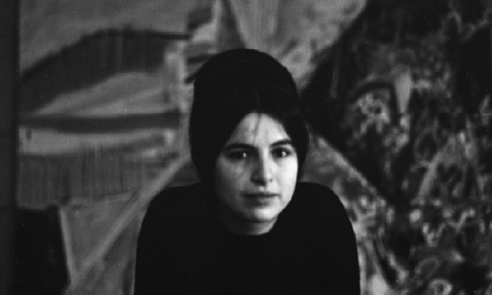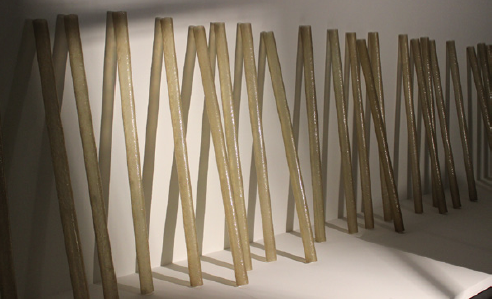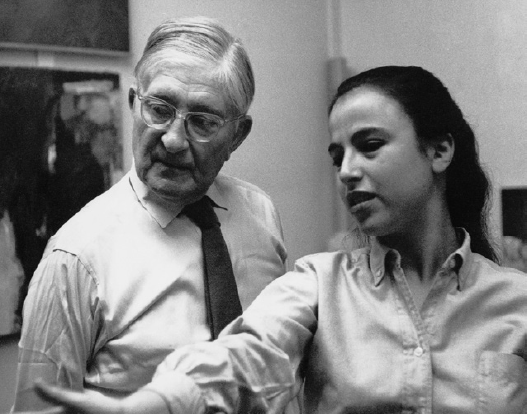Eva Hesse: The Documentary Film
“For me, it’s a total image that has to do with me and life. It can’t be divorced as an idea or composition or form. I don’t believe art can be based on that. This is where art and life come together.” (Eva Hesse)
Eva Hesse kept a review of her daily life as an artist through her journals and letters. Inspiring excerpts of determination, courage, and love of art are kept at Oberlin College’s Allen Memorial Art Museum. Marcie Begleiter’s documentary ”EVA HESSE”, based on the artist’s life was created in part by going through those documents and interviewing her circle of friends, resulting in an honest perspective of Eva Hesse’s life and work. Eva Hesse was born in Hamburg, Germany in 1936. Throughout her life, various challenges and hardships sculpted a talented post minimalist, multidimensional artist who has inspired many (myself included). Hesse’s life and career was cut short due to a malignant brain tumor at the age of 34, just a year after her breakout solo show at the Fischbach Gallery in New York.
The documentary on Eva Hesse’s courageous life and inspirational work will premiere on April 27, 2016 at New York’s Film Forum, followed by a wider release across the country including opening at the Laemmle Monica in Los Angeles on May 13th.
Expose Art Magazine’s Editor in Chief, Chintia Kirana, spoke with Director Marcie Begleiter and Producer Karen Shapiro regarding the challenges and triumphs in making the documentary.
 Marcie Begleiter: Our task to tell a story about someEva Hesse one who passed on 45 years ago, before cell phones and digital media, and who was not very well known before she died. We have constructed a one hundred and eight minute film about someone for whom there was very limited footage and one audio interview. We were lucky. It was fun and yet a real challenge; we did a lot of research and found archives of photos and letters that had never been published. To create a life and bring that forward, that was the goal. Certainly the work is there, the art is there and because of all the writing and archival photos and bits of film, the life is there as well.
Marcie Begleiter: Our task to tell a story about someEva Hesse one who passed on 45 years ago, before cell phones and digital media, and who was not very well known before she died. We have constructed a one hundred and eight minute film about someone for whom there was very limited footage and one audio interview. We were lucky. It was fun and yet a real challenge; we did a lot of research and found archives of photos and letters that had never been published. To create a life and bring that forward, that was the goal. Certainly the work is there, the art is there and because of all the writing and archival photos and bits of film, the life is there as well.
Karen Shapiro: Constructing a film with such limited resources regarding our main character was very challenging for our editor. On the other side, what was amazing is that although Eva didn’t have a computer or a cell phone, she wrote all the time, kept journals and datebooks and we had access to all of it. Marcie and Azin Samari, our editor were able to go through all of those pages and determine what to include and how to tell the story.
MB: Between the journals, letters, and correspondence, we are talking over 1200 pages of writing. There are datebooks that fill in the activity of Hesse’s most productive years. It was a buried treasure.
KS: Going in, we knew we wanted the narration to be in her voice.
MB: Selma Blair is the Voice of Eva Hesse, reading from the artist’s letters and journals, Bob Balaban is William Hesse, Eva’s father (who also wrote voluminous datebooks which are excerpted in the narration) and Patrick Kennedy reads from Sol Lewitt’s letter. We created a feature documentary about an artist who is not very well known outside of the art world. Karen and I raised all the funding – little pieces at a time – that was very challenging. In Europe, you have government support for the arts. The funds in this country were raised through private foundations and individuals, much of it through a non-profit umbrella organization. In addition, Accretion Begleiter Installation view of “Accretion” 1968 Taken at Hamburger Kunsthalle, 2013 Photo by M. Begleiter 43 we raised funding to support the distribution of the film through a Kickstarter campaign.
KS: And about a third of the funding came from Europe as we are a U.S./German co-production. Because of that, we were eligible to receive a grant from the German government which covered the production costs of shooting in Germany for two weeks as well as some of the post production costs including the creation of the musical score and soundtrack and the sound mix. CK: How did the distribution of the film come to fruition?
KS: Zeitgeist Films, out of New York is our U.S. distributor. In Germany, our co-producer, The Cologne based Televisor/Troika, is partnering with the distribution company real fiction. The film will open there in the mid- April as part of ‘Art Cologne’.
MB: In addition to screening the film, we have put together a presentation called “The Unseen Eva Hesse” that includes backstage photos, archival material and clips from some of the artist interviews not included in the film. We have so much amazing material that could not be included in the documentary because of time constraints. We would be most happy to talk to museums and schools about bringing the film and this related programming to their institutions. CK: What are your hopes for the future of this film?
MB: Karen and I have certainly talked about that. Our wish is for the film to find a diverse and worldwide audience. Certainly, people in the art world are core and many of them know something about Hesse and her work already, but our highest hope for the film is that the artist’s life and work becomes known and appreciated outside that community. The film tells its story in a way that a variety of people from different parts of the world can Untitled drawing by Eva Hesse, Watercolor and ink on paper. circa 1963. Eva Hesse in loft, lower Manhattan 1963 Photo by Barbara Brown 45 connect with it. We are looking for connection. We are going to be working really hard to support that.
 KS: I want people to get excited about Eva. I look at this as a personal story, not just a story about an artist. My background is film, not art (as with Marcie). I look at this story as one about a person whose art came from her life and her life came from her art and how the two intertwined. I think Marcie has done an incredible job in telling that story and has balanced the two in such a sensitive way. This is a compelling story that we hope all people will be interested in, not just art students or artists. It’s definitely for many audiences. CK: So where can we see the film?
KS: I want people to get excited about Eva. I look at this as a personal story, not just a story about an artist. My background is film, not art (as with Marcie). I look at this story as one about a person whose art came from her life and her life came from her art and how the two intertwined. I think Marcie has done an incredible job in telling that story and has balanced the two in such a sensitive way. This is a compelling story that we hope all people will be interested in, not just art students or artists. It’s definitely for many audiences. CK: So where can we see the film?
KS: We are so excited and fortunate to open at Film Forum in New York on April 27th for a minimum of two weeks. We have at least a one week run here in L.A. beginning May 13th at the Laemmle Monica and other cities across the country are in the midst of being arranged. That said, the film will be screened in a special event at the National Gallery on February 27th. Check out www.evahessedoc.com for updates on screenings.
MB: The film will also be screened throughout Germany, and there is a TV version that so far we know will be broadcast in France, The Netherlands, Sweden, and Germany later this year. And her journals will be published in may by Yale Press. It’s a big year for Eva. CK: Will you ladies be there for Film Forum? MB: We will certainly be there on April 27th to welcome our first theatrical audience.
KS: Eva’s sister Helen, who is in the film and lives in New York, will also be there. Marcie’s advice for creatives: Writing skills are so important to getting a big project off the ground. Developing these skills so you can write a great project proposal and cover letter are key to getting others on board with your idea. Be passionate and thoughtful as well as well-researched and practical. “EVA HESSE” was a large project and there are literally hundreds of people who helped create it. The film began life as an idea and written proposal and this week we are working on our press release…still writing away.
To contact the director or producer:
info@evahesse.com or bdksprod@gmail.com
For more articles visit: www.exposeartmagazine.com To submit article visit: www.exposeartmagazine.com/submit


